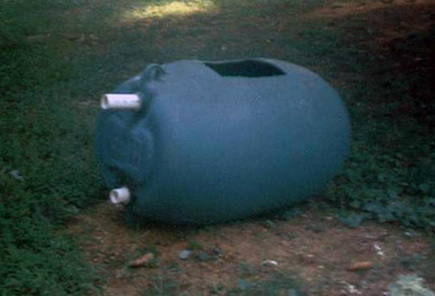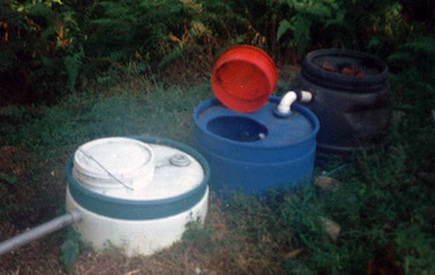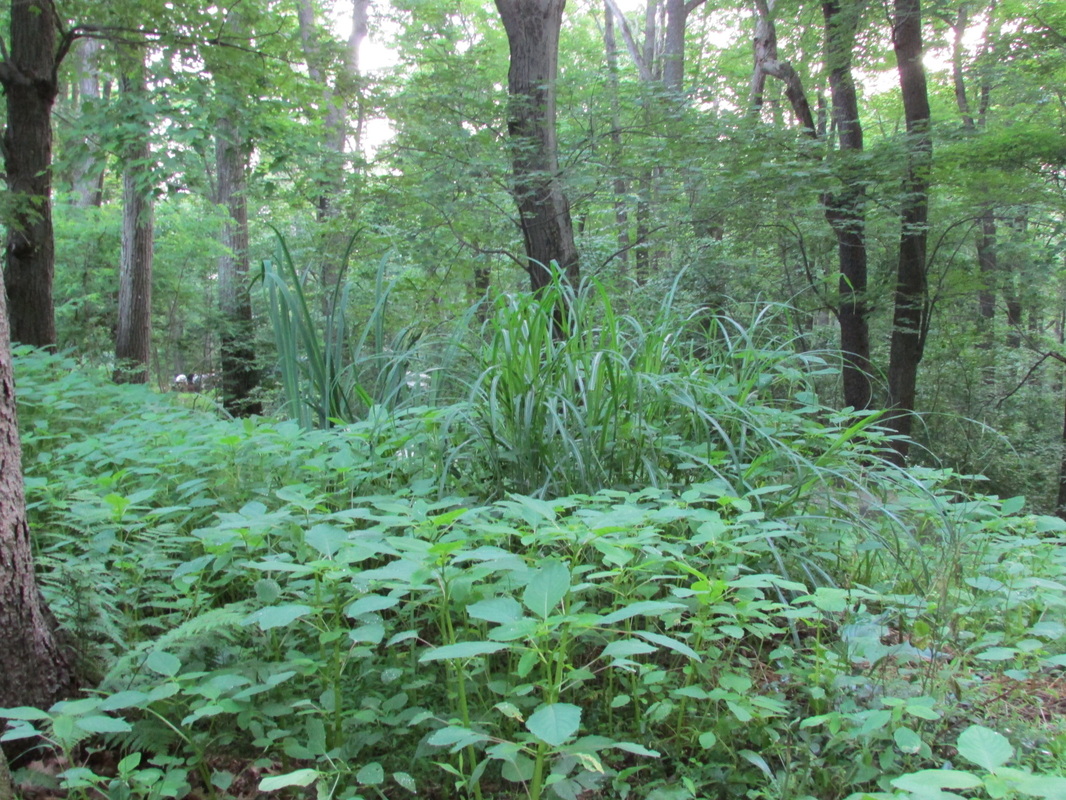Water
We have access to two reliable springs at the foot of the mountain. During the maple tap we drink tree water. Our utility water source is rainwater held in cisterns. It’s soon to evolve the potential to produce potable water too.
Our first elaborated rain water collection system was a platform about 4.5 feet off the ground. On it sat 4 brand new plastic garbage plumbed together in such a way that as you filled one you filled them all. Then we simply ran a garden hose from it through the window to the kitchen sink. In winter we’d bring in 2 of them and set them about 18 inches above the floor level. Then we’d bring the rainwater from the gutter through the hose in the window to fill them up.
Now I have cisterns underground everywhere. The main one that sits above the upper cabin is 1,500 gallons. It's like a water tower system but it's underground and won't freeze. Because of its rise in elevation it gives the house about 14 psi water pressure. We formed and poured it with concrete 7AM to midnight, non-stop mixing.
Our first elaborated rain water collection system was a platform about 4.5 feet off the ground. On it sat 4 brand new plastic garbage plumbed together in such a way that as you filled one you filled them all. Then we simply ran a garden hose from it through the window to the kitchen sink. In winter we’d bring in 2 of them and set them about 18 inches above the floor level. Then we’d bring the rainwater from the gutter through the hose in the window to fill them up.
Now I have cisterns underground everywhere. The main one that sits above the upper cabin is 1,500 gallons. It's like a water tower system but it's underground and won't freeze. Because of its rise in elevation it gives the house about 14 psi water pressure. We formed and poured it with concrete 7AM to midnight, non-stop mixing.
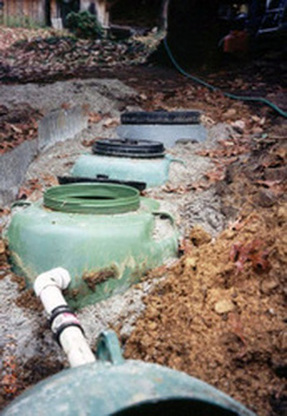
Illustration #1 - First 3 clarification tanks and
Only one thing contradicted itself in our utility water system. That was our own opinion of it. For years we thought we had the most insecure source of water. But then over the years we actually experienced a few intense droughts that lasted several weeks. What we saw surprised us and made us see that instead we had the most secure system. Everyone’s spring and well had long run dry. People were trucking in water. Then every time there was a little cloudburst, even a full inch, it didn’t replenish any of the ground sources for water. We however collected huge amounts from even these little cloudbursts.
Leaves and particles are mildly filtered through screens and then we rely on the water to just settle out in the tanks. By then it’s pretty clean and clear. Old timers used to throw Alum in their cisterns to settle it quickly but that scares me. Occasionally I toss in a minimum amount of pool chlorine to kill any harmful stuff. I don’t drink the utility water mainly because of the idea of birds shitting on the roof. People have drunk it by mistake and they didn’t die.
The reason I said we’re about to be able to drink cistern water is because I just installed a pressurizing system to feed the distillery coils. I needed the same system to drive water through reverse osmosis. Basically we’re tired of carrying spring water for the dogs. And if we do get the big drought I’m ready.
I also picked up a few ultraviolet units at the flea market. They will kill most harmful organisms. It would be nice to just switch one on in a cistern for a minute every once in a while to eliminate the use of chlorine.
The first installation of the gray water treatment plant presented a minor problem with grease and particles or grease clinging to particles. There was a trap I had to clean every 5 or so years. I’ll just go into describing the system as it is now after the first upgrade to eliminate that problem. It’ll explain how I dealt with the problem.
Leaves and particles are mildly filtered through screens and then we rely on the water to just settle out in the tanks. By then it’s pretty clean and clear. Old timers used to throw Alum in their cisterns to settle it quickly but that scares me. Occasionally I toss in a minimum amount of pool chlorine to kill any harmful stuff. I don’t drink the utility water mainly because of the idea of birds shitting on the roof. People have drunk it by mistake and they didn’t die.
The reason I said we’re about to be able to drink cistern water is because I just installed a pressurizing system to feed the distillery coils. I needed the same system to drive water through reverse osmosis. Basically we’re tired of carrying spring water for the dogs. And if we do get the big drought I’m ready.
I also picked up a few ultraviolet units at the flea market. They will kill most harmful organisms. It would be nice to just switch one on in a cistern for a minute every once in a while to eliminate the use of chlorine.
The first installation of the gray water treatment plant presented a minor problem with grease and particles or grease clinging to particles. There was a trap I had to clean every 5 or so years. I’ll just go into describing the system as it is now after the first upgrade to eliminate that problem. It’ll explain how I dealt with the problem.
|
As you can see in the first illustration, the first 3 vertical standing 75 gallon plastic olive drums act merely as water clarifiers. There are baffles in all three so that only the cleanest water exits from one and enters the next. These were part of the first upgrade. All 3 tanks do different things with the gray water to clarify it. When the water from our drains enters the first tank, it’s directed in such a way that it swirls it in a vortex. When the water reaches the 3rd tank it’s released at the bottom so as to accentuate the settling process and exits through its baffle near the top. Right this minute I can’t remember how I designed second tank, but it’s different from #1 and #3.
The 4th filter (illustration 2) lies horizontally and is filled with huge chunks of lava rock. It also acts as a surge tank so the next 3 aggregate filled vertical drums #5, #6 and #7 (illustration 3) can take their good old time doing their job. By surge tank I mean if #5 #6 and #7 aggregate filters can only handle 5 gallons a minute, you can still pour 50 gallons down the drain. #5 is filled with crushed lava rock and #6 and #7 are filled with aggregate (stones) that get smaller and smaller until the water has to percolate through sand and then fine road ash. I was just starting to assemble these filters to percolate the water downward through the aggregate when I was suddenly struck with the logic of percolating the water upward from the bottom so I changed their design in mid construction. That’s because, as I said earlier, the upward flow works with the tendency of impurities to settle down. That meant I had to pack the aggregates into their drums in reverse, which is larger grade on the bottom graduating to a finer grade on top |
Not shown is a black 4 “ donut shape that’s at the bottom of each aggregate filter. That’s a special flexible perforated pipe designed to release water into a leach field. That’s how I released the water at the bottom so it percolates up toward the top. The donut is set on a few bricks so there’s some space for stuff to settle and bidegrade in.
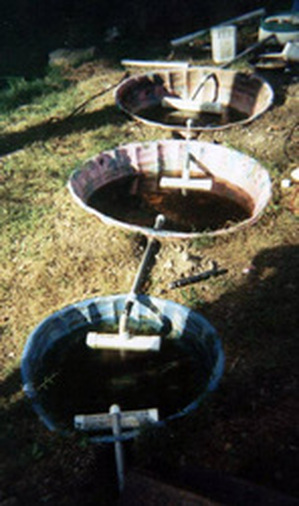
Illustration #4 - living pools, filters 8, 9, and 10
these are now filled with plant life!
these are now filled with plant life!
Filters #8, #9, and #10 are living pools (illustration 4). They each contain various plants that I introduced into them plus others that seeded themselves. Currently after the water flows consecutively through the roots of the plants in these 3 pools it enters the center of our main compost heap. These are made from those common little plastic wading pool that you see for sale outside Wallmart and Kmart. Each pool is double lined so really I used six of these pools. The illustrations show how the water is released into one end of the pool and collected at the other end to be transferred to the next pool through 1 ½” PVC Pipe. At first the transfers didn’t work until I discovered there was an airlock in each pipe. A small hole remedied that but that hole had to be protected from anything that might clog it. A plastic dish scrubber clamped loosely over the hole did the trick.
Apparently the gray water was quite appetizing to one bear that ripped off the lid of #7 drums to drink off the top of it. Apparently it’s filled with nutrients too because some of the growth in particular plant species borders on scary. I once saw the biggest coltsfoot leaf I ever saw in my life grow out of one of the pools. They’re on the average maybe 4 to 8 inches wide. This one was about 18 inches wide.
If you’re just doing dishes or taking a shower no water actually comes out the very end of the system in summer. It’s all taken up by the plants and transpired into the air.
I’m so excited about the next up grades but that won’t be for a number of years. Only days ago I realized if I put a float gauge in the horizontal surge tank, I’ll have direct knowledge about how efficiently the next three aggregate filters are working. Also having learned about how grease and particles behave, I have a sort of removable plastic grease magnet in mind for the #1 clarifier tank.
One of the neatest experiments I have in mind will use salvaged fiber optics from lamps I picked up at the flea market for a buck or two. Using a Fresnel lens I want to gather and concentrate ambient natural light send it down these fiber optics through the sealed lid on #3 clarification tank. With the addition of an aquarium aerator I want to see what grows on the ends of the lit fibers and see if it accentuates the filtration. I’ll have to vent the lid and send it up parallel to the toilet vent in case of unpleasant odor.
The whole gray water system is designed for a quick change in the event of a severe drought (which I do foresee is coming). When that happens the living pools are no more. Instead I will tap onto the pipe that comes out of #7 (the last aggregate filter) and direct that flow to a Y joint with 2 valves. One valve will open to a set of filters I have that will prepare the water for reuse as utility water (Wash, sink, shower). The other valve will send it through a much more aggressive filtration system that will make it potable and drinkable.
Kathy say’s I’m a hoarder. She’s right. In my manic eccentricity I’ve been collecting filters for 30 odd years. I have every kind imaginable. I have diatomaceous earth, sand, ceramic, charcoal, every medium of sediment filter and ones that remove all chemicals. I have from 2 to 5 of every kind of sink top water filter as well as at least 15 of the canister ones you plumb in under the sink. I have 3 Reverse Osmosis systems and even one that was modeled after the space shuttle’s system that will filter urine so you can drink it. (Don’t think I’ll be trying that any time soon).
One brand new reverse osmosis system I have retailed for $700. I also have a brand new Kenmore system that cost around $500. The third is a cheaper smaller compact unit. Now get this!! I paid total around $15 for all three of these R.E. filters at the flea market!!
There is a culture of people who buy out estates. The stuff they get from cleaning out the houses and garages is their inventory to set up and sell. They amass so much inventory that they either turn it over quick and cheap or they drown in it. In the case of these R.E. filters, they had no idea what they had and sold them for dirt.
Apparently the gray water was quite appetizing to one bear that ripped off the lid of #7 drums to drink off the top of it. Apparently it’s filled with nutrients too because some of the growth in particular plant species borders on scary. I once saw the biggest coltsfoot leaf I ever saw in my life grow out of one of the pools. They’re on the average maybe 4 to 8 inches wide. This one was about 18 inches wide.
If you’re just doing dishes or taking a shower no water actually comes out the very end of the system in summer. It’s all taken up by the plants and transpired into the air.
I’m so excited about the next up grades but that won’t be for a number of years. Only days ago I realized if I put a float gauge in the horizontal surge tank, I’ll have direct knowledge about how efficiently the next three aggregate filters are working. Also having learned about how grease and particles behave, I have a sort of removable plastic grease magnet in mind for the #1 clarifier tank.
One of the neatest experiments I have in mind will use salvaged fiber optics from lamps I picked up at the flea market for a buck or two. Using a Fresnel lens I want to gather and concentrate ambient natural light send it down these fiber optics through the sealed lid on #3 clarification tank. With the addition of an aquarium aerator I want to see what grows on the ends of the lit fibers and see if it accentuates the filtration. I’ll have to vent the lid and send it up parallel to the toilet vent in case of unpleasant odor.
The whole gray water system is designed for a quick change in the event of a severe drought (which I do foresee is coming). When that happens the living pools are no more. Instead I will tap onto the pipe that comes out of #7 (the last aggregate filter) and direct that flow to a Y joint with 2 valves. One valve will open to a set of filters I have that will prepare the water for reuse as utility water (Wash, sink, shower). The other valve will send it through a much more aggressive filtration system that will make it potable and drinkable.
Kathy say’s I’m a hoarder. She’s right. In my manic eccentricity I’ve been collecting filters for 30 odd years. I have every kind imaginable. I have diatomaceous earth, sand, ceramic, charcoal, every medium of sediment filter and ones that remove all chemicals. I have from 2 to 5 of every kind of sink top water filter as well as at least 15 of the canister ones you plumb in under the sink. I have 3 Reverse Osmosis systems and even one that was modeled after the space shuttle’s system that will filter urine so you can drink it. (Don’t think I’ll be trying that any time soon).
One brand new reverse osmosis system I have retailed for $700. I also have a brand new Kenmore system that cost around $500. The third is a cheaper smaller compact unit. Now get this!! I paid total around $15 for all three of these R.E. filters at the flea market!!
There is a culture of people who buy out estates. The stuff they get from cleaning out the houses and garages is their inventory to set up and sell. They amass so much inventory that they either turn it over quick and cheap or they drown in it. In the case of these R.E. filters, they had no idea what they had and sold them for dirt.
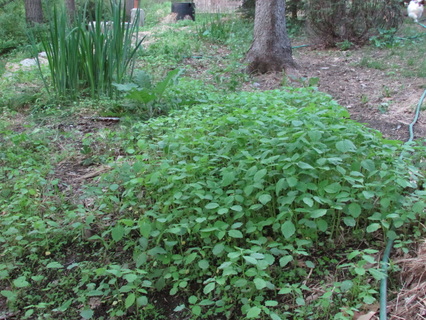
3 living water filters.
Pools hidden in landscape
Pools hidden in landscape



